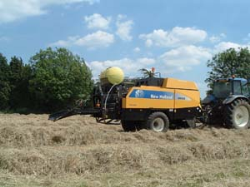
The late spring and consequent delay in silage and hay making means that with plenty of lush crops around, there is a danger that when considering baling forage crops farmers could end up spending a lot of money to bale water.
The lush grass conditions mean that even after wilting high bale densities will be easy to achieve. However whilst there will be plenty of bulk, this does not necessarily correspond to good quality. And with film and disposal costs to factor in also, how cost effective is it to make round bale silage, questions Richard Snell of the Profitable Farming Company.
With modern hay making techniques using preservatives that allow grass to be baled at between 16% up to 30%, it is possible to make better quality hay in less time and at far less cost. In fact recent research has shown there are benefits to baling hay slightly damper that historically has been the case.
"Recent research has shown that hay baled at 22% will yield 14% per acre more due to reduced leaf shatter and moisture loss, and the relevant feed value rises resulting in higher intake. Also, the longer the crop is left to dry down naturally, the higher the risk of rain."
"Whilst in the past it was not wise to bale hay at anything above 16% moisture, with modern safe propionic based preservatives such as Baler's Choice it is now possible to round or big bale hay at moisture contents up to 30%"
"With silage, water can account for up to 50%-plus of what you bale, so essentially you are paying a high cost to conserve water. Therefore it is important that when looking at options that you don't just look at the cost/bale, but that you look at the cost/tonne dry matter. After all livestock only convert feed value from dry matter not from water."
